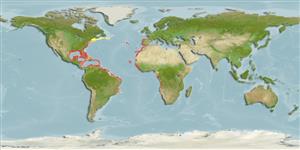Classification / Names
Common names from other countries
Main reference
Size / Weight / Age
Max length : 200 cm TL male/unsexed; (Ref. 26938); common length : 120 cm TL male/unsexed; (Ref. 5217)
Environment
Marine; brackish; reef-associated; depth range ? - 200 m (Ref. 9710)
Climate / Range
Tropical, preferred 23°C (Ref. 107945); 45°N - 23°S
Distribution
Eastern Atlantic: Cape Blanc and Cape Verde to Angola. Western Atlantic: Bermuda, Georges Bank, and southern Canada to Brazil (Ref. 7251). Gulf of Mexico, Antilles, Central and South American coasts Ref. (26938).
Countries | FAO areas | Ecosystems | Occurrences | Introductions
Short description
Dorsal
spines
(total): 0;
Dorsal
soft rays
(total): 14-16;
Anal
spines: 0;
Anal
soft rays: 14 - 16;
Vertebrae: 87. Color in life brownish above, lighter below, with a series of pale blue spots from head to dorsal fin on midline of back, row of blue spots lateral to the mid-dorsal row and two lateral rows of blue spots on snout. First four vertebrae fused (Ref. 9826). Middle caudal rays extended as a long filament; no scales or fin spines. No barbel at tip of lower jaw (Ref. 26938)
IUCN Red List Status (Ref. 115185)
Threat to humans
Harmless
Human uses
Fisheries: minor commercial
More information
ReferencesAquacultureAquaculture profileStrainsGeneticsAllele frequenciesHeritabilityDiseasesProcessingMass conversion
Tools
Special reports
Download XML
Internet sources
Estimates of some properties based on models
Phylogenetic diversity index
PD50 = 0.6250 many relatives (e.g. carps) 0.5 - 2.0 few relatives (e.g. lungfishes)
Trophic Level
3.7 ±0.4 se; Based on diet studies.
Resilience
Vulnerability
High to very high vulnerability (71 of 100)
Price category
